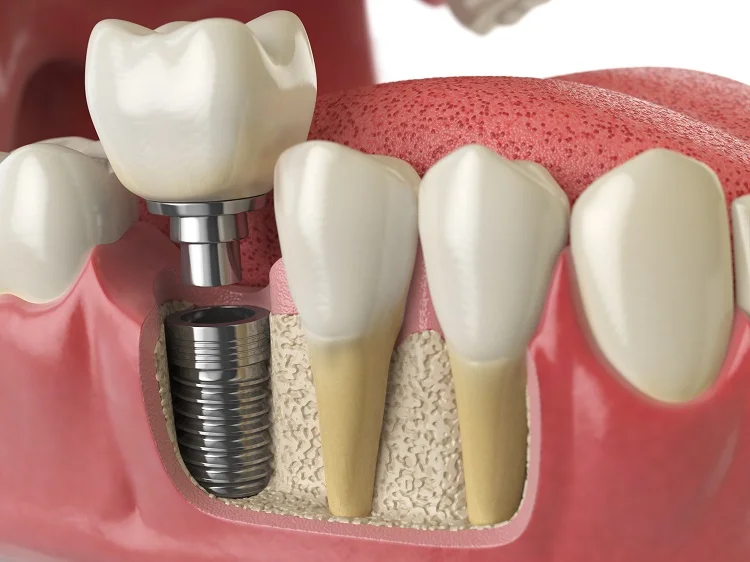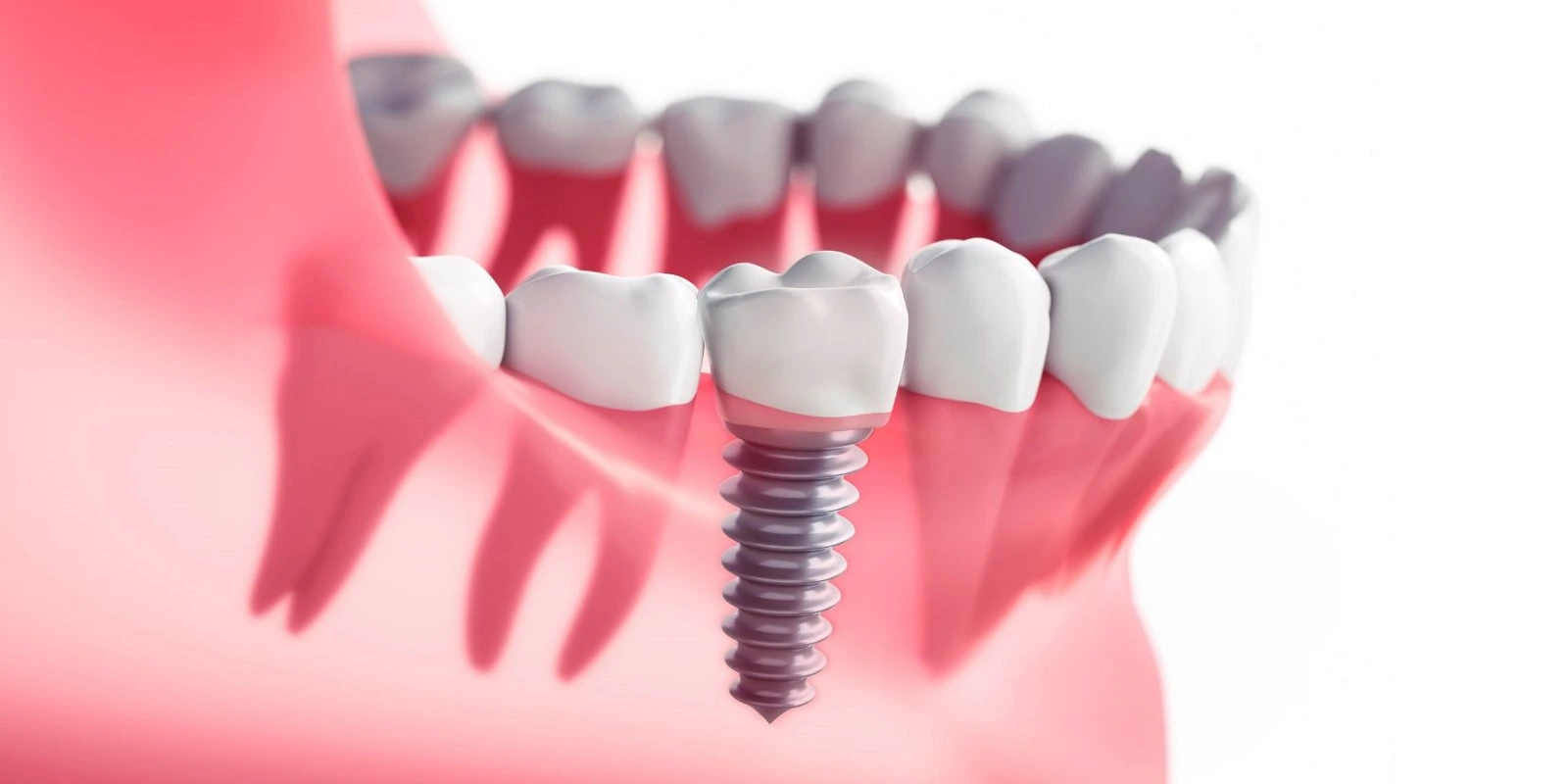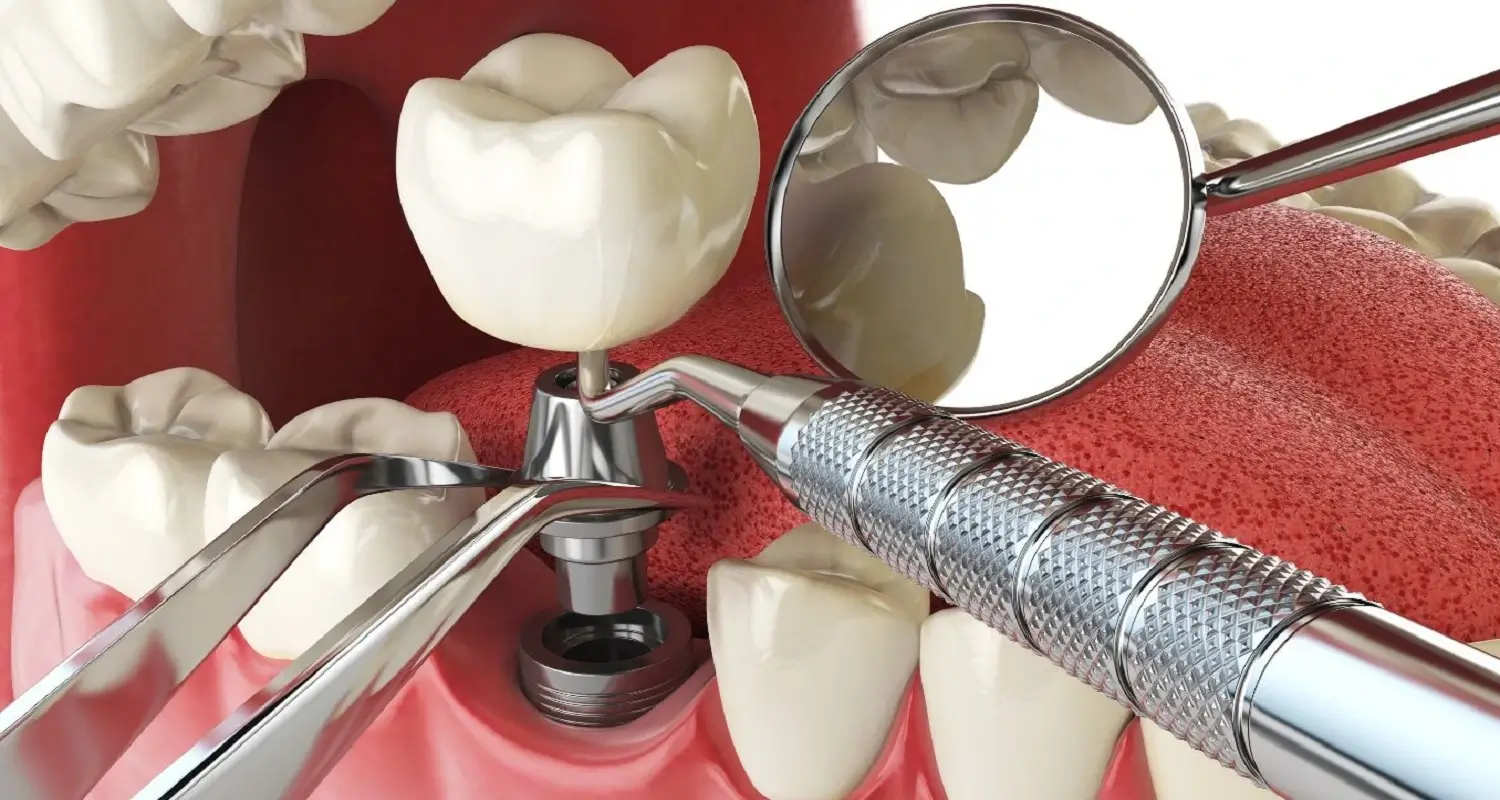Last Updated on: 10th December 2025, 05:36 am
Dental implants are one of the most modern and effective solutions for replacing missing teeth. These devices offer a durable and aesthetic alternative to removable dentures or fixed bridges, allowing people to replace lost teeth, smile confidently again, and chew comfortably. In this article, we explain in detail everything you need to know about dental implant procedure.
What is a Dental Implant?
A dental implant is a device made of a tissue-friendly material (usually titanium or ceramic) that is surgically placed in the patient’s jawbone or maxilla to replace the root of the missing tooth.
A dental crown or prosthesis is then placed over the implant.
The dental implant is designed to integrate with the bone through a process called osseointegration, which provides a solid and stable base to replace missing teeth.
Once the dental implant has osseointegrated, it can be used to support an individual crown, a dental bridge, or a complete dental prosthesis, making it a versatile solution for replacing one or more missing teeth.
Types of Dental Implants
According to the depth of placement, implants can be of two types:
• Endosteal dental implants: These are the most common dental implants and are placed directly into the patient’s jawbone or maxilla.
They are available in different shapes and sizes, including cylindrical, conical, and threaded. Endosteal implants are ideal for patients with sufficient bone height and width.
• Subperiosteal dental implants: These are less common dental implants that are placed under the gingival tissue but above the maxillary bone. They are used when:
• The patient does not have enough healthy natural mandibular bone and cannot, or does not wish to, undergo a bone augmentation procedure to rebuild it.
• It is not possible to perform overly invasive treatments.
Benefits of Dental Implants
Dental implants offer numerous advantages for patients who need to replace missing teeth. Among the most notable benefits are:
1. Restoration of oral function
Dental implants integrate with the patient’s jawbone or maxilla, providing a solid and stable base to support dental crowns, bridges, or prostheses. This allows patients to regain the ability to chew and speak normally, improving their quality of life.
2. Improvement of dental aesthetics
Dental implants are designed to look and feel like natural teeth. They are customized to fit perfectly with the shape, size, and color of adjacent teeth, providing an aesthetic and natural appearance.
3. Securing dentures
When patients have lost all or most of their teeth, it is possible to make prostheses that fit onto the implants either removable or permanently, which significantly reduces movement of the prosthesis and increases comfort.
4. Preservation of bone and facial structure
Tooth loss can lead to dental resorption of the jawbone or maxilla, which can result in an aged facial appearance and a change in facial structure.
Dental implants prevent bone loss, helping to preserve facial structure and maintain a more youthful appearance.
5. Greater comfort and convenience
Unlike removable dentures, dental implants are fixed in the bone, eliminating the need for adhesives or worrying about them moving or falling out during speech or chewing.
6. Allow for the replacement of missing teeth without affecting adjacent teeth
Contrary to what happens with fixed bridges made on natural teeth, when dental implants are placed, it is not necessary to wear down the structure of neighboring teeth for their placement.
Which Patients are Candidates for Dental Implant Procedure?
Dental implants are a viable option for a wide range of patients who need to replace one or more missing teeth. These include patients:
• With tooth loss due to decay, periodontal disease, trauma, or congenital anomalies.
• Who are not candidates for removable dentures or fixed bridges because they do not have enough healthy adjacent teeth or have little bone support.
• Seeking a durable and aesthetic solution to replace missing teeth without affecting adjacent teeth.
• Removable prosthesis users seeking to improve their quality of life, oral function, and dental aesthetics.
In which Patients is it not Advisable to Place Dental Implants?
Dental implants may not be suitable for patients who:
• Have not completed their bone growth and development.
• Smoke or use of tobacco.
• Have lost too much mandibular bone.
• Have poor oral hygiene.
• Have uncontrolled or untreated gum disease.
• suffer from diseases such as bone disorders or autoimmune diseases.
In patients who have lost too much height of the maxillary bones and this does not allow proper implant placement, the surgeon may recommend additional procedures such as bone augmentation, maxillary sinus lift, or ridge expansion.
What is the Proper Dental Implant Procedure?
The dental implant placement procedure generally consists of several stages, including:
1. Evaluation and planning
In this initial stage, the dentist will conduct a comprehensive evaluation of the patient’s oral health, which may include radiographs, CT scans, and study models. Detailed case planning will be performed, taking into account the location, quantity, and quality of available bone, as well as the patient’s aesthetics and needs.
2. Implant placement
The next step is the placement of the dental implant in the jawbone or maxilla. This is done under local anesthesia, making a small incision in the gums.
Followed by creating an opening in the bone that will be expanded to obtain the required space for the implant. The implant is then inserted, the gum is repositioned, and some sutures are placed.
3. Healing and osseointegration
After implant placement, the bone and surrounding tissues are allowed to heal and the implant integrates with the bone. This can take several weeks or months, depending on the patient’s healing speed.
4. Placement of the dental crown
Once the implant has healed and integrated with the bone, the selected dental crown or prosthesis will be placed.
5. Follow-up and care
After the placement of the crown or prosthesis, the dentist will perform periodic follow-ups to ensure that the implant is functioning correctly and that the patient is satisfied with the results. In addition, appropriate oral care instructions will be provided to ensure the long-term durability and success of the dental implant.
When you can’t take care of them correctly, cavities may develop. To find out more, read our article “Cavities Under Dental Crowns“.
Recovery and Aftercare Following the Procedure
After the surgery, it is normal to experience pain, discomfort, and swelling.
To ensure the success of the procedure and promote healing, it is favorable to follow the following recommendations:
• Take all medications exactly as prescribed by the professional in charge of the procedure.
• Avoid self-medication.
• Do not consume hard or hot foods for the first 2 days.
• Take relative rest: Avoid exercising, bending over, or lifting heavy objects for at least 72 hours
• Do not smoke.
• Clean the intervened area according to the instructions of your surgeon.
• Chew on the opposite side of the implant.
• Avoid disturbing the wound.
• Eat healthy and balanced to promote the healing process.
• Avoid stressful situations.
• Attend scheduled follow-up appointments with the dentist to evaluate the progression of healing and ensure everything is in order.
Regular check-ups with a dentist and maintaining good hygiene are essential to guarantee the durability of the implant and the health of the surrounding tissues.
Although these devices are not susceptible to cavities, adjacent teeth, and structures could be affected by poor hygiene conditions, which could imply the loss of the implant and the surrounding bone.
What are the Risks and Complications of Dental Implant placement?
Some of the possible risks and complications of dental implant placement include:
1. Infection: An infection in the area of the dental implant can occur, which may require treatment with antibiotics or even the removal of the implant in severe cases.
2. Implant rejection: In rare cases, the body may reject the dental implant, which can result in implant loss.
3. Persistent pain: Some patients may experience persistent pain in the area of the dental implant, which may require further evaluation and treatment by the dentist.
Damage to nearby structures: During the implant placement procedure, there is a risk of damaging nearby structures such as adjacent teeth, nerves, or blood vessels.
Adjacent structures such as the maxillary sinuses could also be affected.
5. Nerve damage: During the preparation of the bone to receive the implant or the implant insertion itself, nearby nerve structures could be affected, resulting in a numb sensation known as paresthesia.
Depending on the severity, this could be temporary or permanent.
6. Allergic reactions to implant material: Although not a common situation, some cases of allergic reactions to titanium have been reported.
Conclusion
Dental implant procedure are an excellent option for replacing missing teeth and restoring dental function and aesthetics. By following the dentist’s instructions, maintaining good oral hygiene, and attending scheduled follow-up appointments, the success and durability of dental implants can be maximized.
Dental implant procedure must be performed by an experienced and qualified dentist to evaluate eligibility and perform the procedure safely and successfully.
Share:
References
1. Dental implants. (Nov 21, 2022). Cleveland Clinic. Recuperado el 12 de abril de 2023, de https://my.clevelandclinic.org/health/treatments/10903-dental-implants
2. Dental implants: What you should know. (Oct 29, 2021). U.S. Food and Drug Administration; FDA. Recuperado el 12 de abril de 2023, de https://www.fda.gov/medical-devices/dental-devices/dental-implants-what-you-should-know
3. Implants. (s/f). Mouthhealthy.org. Recuperado el 12 de abril de 2023, de https://www.mouthhealthy.org/all-topics-a-z/implants/
4. Stanford, C. M. (2007). Dental implants. Journal of the American Dental Association (1939), 138, S34–S40. https://doi.org/10.14219/jada.archive.2007.0361
5. Types of implants & techniques. (Feb 24, 2021). The Dental Implant Experts; AAID Credentialed Dentists. https://www.aaid-implant.org/what-are-dental-implants/types-of-implants-and-techniques/
6. Whelan, C. (May 3, 2021). Dental implant procedure: What to know. Healthline. https://www.healthline.com/health/dental-and-oral-health/dental-implant-procedure
-
Nayibe Cubillos M. [Author]
Pharmaceutical Chemestry |Pharmaceutical Process Management | Pharmaceutical Care | Pharmaceutical Services Audit | Pharmaceutical Services Process Consulting | Content Project Manager | SEO Knowledge | Content Writer | Leadership | Scrum Master
View all posts
A healthcare writer with a solid background in pharmaceutical chemistry and a thorough understanding of Colombian regulatory processes and comprehensive sector management, she has significant experience coordinating and leading multidisciplina...



















